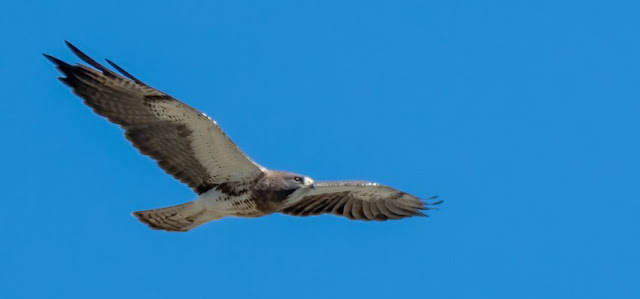A Morning with Mississippi Kites
By Dan Weisz
 |
| All photos by Dan Weisz |
There is an area of Cochise County where you can see a very special bird in spring and summer that is uncommon in Arizona: the beautiful Mississippi Kite.
So what is a bird called a “Mississippi Kite” doing in southern Arizona? A look at the range map below shows an interesting breeding area for this species. During our winters, all Mississippi Kites spend their time in subtropical South America, mostly Argentina and Brazil. During breeding season, they make their way to their breeding grounds in America noted by the color orange on the map. Besides the solid orange breeding area, there are many scattered orange “spots” where Mississippi Kites have established generations of breeding populations, including in Arizona.
Mississippi Kites were first named and described by a European ornithologist in 1811 after observing the species in what was then called the Mississippi Territory. The species wasn’t recorded in Arizona until 1970. Although they can occur in many places in Arizona, their most regular breeding area is along the San Pedro River.
The female (above) was soon joined by her male partner. Mississippi Kites are monogamous. During nest building, they continue to mate and pair-bond regularly. We were able to see a number of these episodes.
Male and female kites look alike: they have red eyes surrounded by dark feathers and skin, light gray backs with darker wing and tail feathers, and the heads of males are lighter than the females. Males also have a light brown highlight across the middle of the wing feathers. In this shot, you can see the different shades of his back plumage, from the near white of his head to the middle gray of his back to the dark gray of his wing ends and tail feathers.
After a short while, it was time for the male to move on. With his wings extended upwards, he looks like so many other raptors getting ready for their lift-off using a powerful downward stroke of their wings.
And he’s off. The kite may fly out in search of another twig to bring back to the nest. He may be heading out in search of food. He may just be circling his territory to ensure there are no intruders or predators in the area.
What the male does next is variable. Over three hours we observed a somewhat regular pattern of distant flights followed by a return to the nesting area, mating with the female, and repeating this over and over again. A few times he flew right over us, sometimes “kiting,” or hovering in one spot as he surveyed his territory.

Birds reproduce using their cloaca; this occurs during a "cloacal kiss" in most birds. The cloaca is the single posterior opening for a bird's digestive, urinary, and reproductive tracts and is used to expel feces, exchange sperm, and lay eggs.
The area had many other birds, including this Cassin’s Kingbird, with a white “mustache.” There were also Common Ravens in the area, often being harassed by one or more kingbirds or flycatchers. Another showy bird popped up at the top of the tree: a Bronzed Cowbird.
The Mississippi Kites continued to entertain and amaze me. In this shot the male was flying behind the nest tree. Although some of him is ‘clipped’ and hidden by the tree, seeing his dorsal (back) side with his tail feathers spread is a special look at this raptor.
We saw a skirmish in the air. The bird is a first-year Mississippi Kite, likely one of last year’s brood from this same pair. You can see the juvenile tail feathers which look very different from the adult plumage. Sometimes juveniles are allowed to spend their second summer with the parents. In this case, the male let the young one know it was not at all welcome and chased it away vigorously.
One of the last times the male visited the female, the pair bonding involved a different activity: he brought her a lizard to snack on. Here, she has bitten off the lizard’s tail while holding the prey in her talons.
And so our morning ended. I sure hope to see these kites again at some point in the future. I definitely brought home memories to last a lifetime.
Dan Weisz is a native Tucsonan and retired educator who enjoys birding, being in nature, and taking photographs.














Comments
Post a Comment
Thanks, we value your opinions! Your comment will be reviewed before being published.